The Red-billed Tropicbird (Phaethon aethereus) is a striking seabird known for its elegant appearance and distinctive red bill.
Found in tropical and subtropical regions around the world, this species boasts a slender white body with elongated tail feathers, making it a captivating sight both in flight and perched on coastal cliffs.
Renowned for its graceful aerial maneuvers and effortless gliding, the Red-billed Tropicbird primarily feeds on fish and squid, which it catches by diving from great heights into the ocean waters below.
Despite its widespread distribution, these birds are particularly vulnerable to threats such as habitat destruction, pollution, and disturbances to their nesting sites.
Conservation efforts aimed at protecting their breeding colonies and marine environments are crucial for ensuring the survival of this magnificent species for future generations to admire and appreciate.
Physical Characteristics of Red-billed Tropicbird
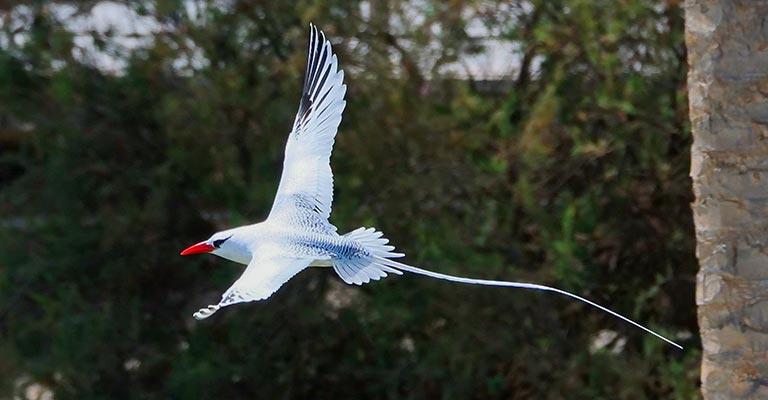
The Red-billed Tropicbird (Phaethon aethereus) is a distinctive seabird characterized by several key physical features that make it easily identifiable:
Red Bill
As the name suggests, one of the most prominent identifying features of the Red-billed Tropicbird is its vibrant red bill.
This bill is long, slender, and sharply pointed, often contrasting strikingly against its predominantly white plumage.
White Plumage
The bird’s body is primarily covered in pure white feathers, giving it a sleek and elegant appearance. This stark white coloration is consistent across the entire body, including the wings, back, and belly.
Long Tail Feathers
One of the most striking features of the Red-billed Tropicbird is its long, streaming tail feathers.
These elongated feathers extend well beyond the bird’s body, often trailing behind it in flight. The tail feathers are white with black edges, adding to the bird’s distinctive silhouette.
Wing Shape
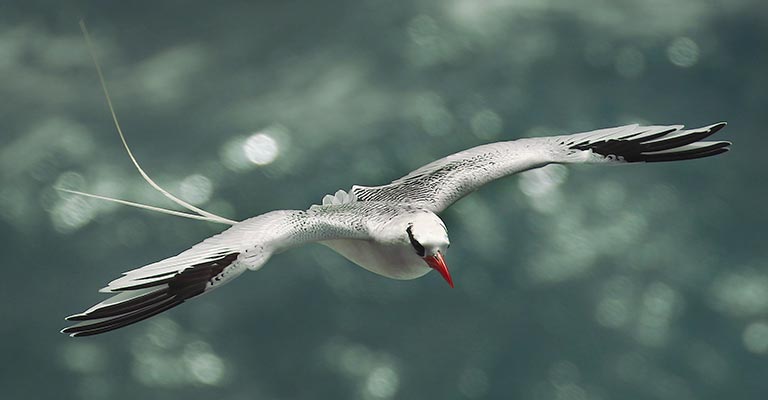
When in flight, the Red-billed Tropicbird displays a unique wing shape characterized by long, narrow wings with a distinctive bend at the wrist joint.
This shape allows for effortless gliding and precise aerial maneuvers, making it well-adapted for its oceanic lifestyle.
Size
The Red-billed Tropicbird is a medium-sized seabird, with adults typically measuring around 40 to 45 centimeters (16 to 18 inches) in length from beak to tail. Its wingspan typically ranges from 90 to 100 centimeters (35 to 39 inches).
Facial Markings
In addition to its red bill, the Red-billed Tropicbird has distinctive facial markings, including black eye patches that extend from the eyes to the bill.
These patches contrast sharply against the bird’s white plumage, further accentuating its striking appearance.
Legs and Feet
The legs and feet of the Red-billed Tropicbird are relatively short and weakly developed, reflecting its primarily aerial lifestyle.
Despite this, the feet are equipped with sharp claws, which are used for perching on rocky cliffs or grasping prey items.
Behavior
In addition to its physical characteristics, the behavior of the Red-billed Tropicbird can also aid in its identification.
This species is often observed soaring effortlessly over coastal cliffs or skimming the surface of the ocean in search of food. Its graceful flight patterns and distinctive calls contribute to its overall impression of elegance and beauty.
Taxonomy of Red-billed Tropicbird
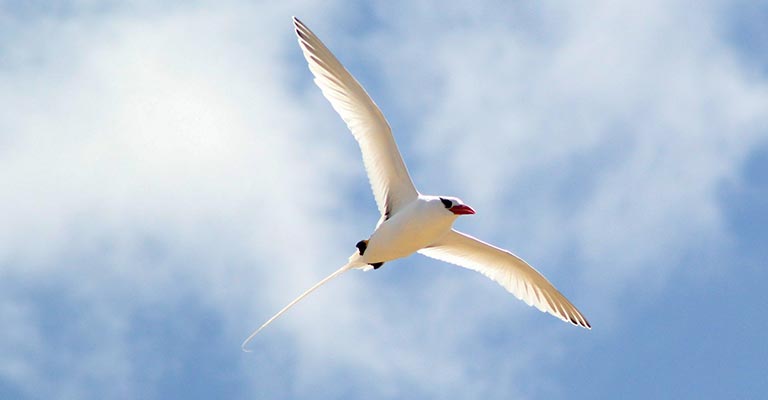
Below is the table detailing the taxonomy of the Red-billed Tropicbird:
| Taxonomic Rank | Classification |
| Domain | Eukaryota |
| Kingdom | Animalia |
| Phylum | Chordata |
| Class | Aves |
| Order | Phaethontiformes |
| Family | Phaethontidae |
| Genus | Phaethon |
| Species | Phaethon aethereus |
The Red-billed Tropicbird (Phaethon aethereus) is a species of seabird known for its distinctive red bill and graceful flight. Within this species, there are three recognized subspecies, each with its own unique characteristics and distribution:
Phaethon aethereus aethereus (Linnaeus, 1758)
This subspecies, often referred to as the nominate subspecies, is found in the tropical Atlantic Ocean, particularly in regions such as the Caribbean and the Gulf of Mexico.
It typically exhibits the classic features of the Red-billed Tropicbird, including a white body, red bill, and long tail feathers.
Phaethon aethereus mesonauta (J. L. Peters, 1930)
The mesonauta subspecies is native to the central and eastern Pacific Ocean, including areas such as the Galápagos Islands and the coast of Central America.
While similar in appearance to the nominate subspecies, mesonauta tropicbirds may exhibit slight variations in plumage coloration and size, influenced by their specific geographic range.
Phaethon aethereus indices (A. O. Hume, 1876)
Found in the Indian Ocean and surrounding waters, including the Seychelles and the Maldives, the indicus subspecies of the Red-billed Tropicbird displays adaptations suited to its particular environment.
These adaptations may include variations in plumage coloration or slight differences in bill shape, influenced by factors such as diet and habitat.
Despite these subspecific distinctions, all populations of Red-billed Tropicbirds share similar ecological roles and behaviors, primarily feeding on fish and squid caught by plunge-diving from great heights.
Reproduction of Red-billed Tropicbird
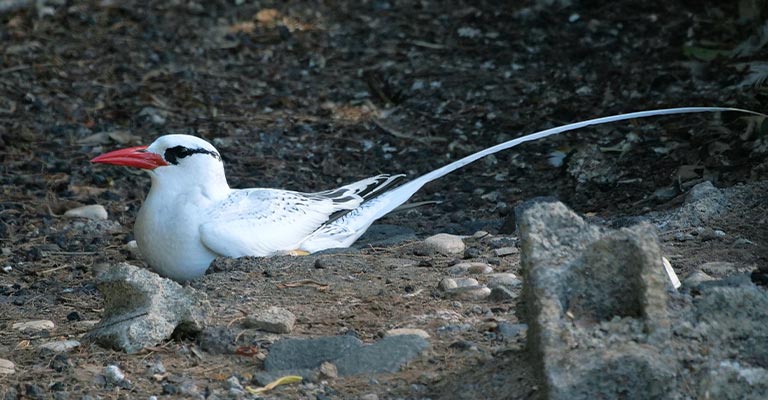
Red-billed Tropicbirds typically breed in colonies on remote coastal cliffs or rocky islands.
During the breeding season, which varies depending on the location, pairs engage in elaborate courtship displays involving aerial acrobatics and mutual preening.
Once a pair forms a bond, they construct a simple nest out of gathered debris, often in a sheltered crevice or on a cliff ledge.
The female lays a single egg, which both parents take turns incubating for about 40-46 days. After hatching, the chick is cared for by both parents and fed a diet of regurgitated fish and squid.
It takes around 70-80 days for the chick to fledge and become independent. Red-billed Tropicbirds typically exhibit high nest fidelity, returning to the same breeding sites year after year to raise their young.
Red-billed Tropicbird Life History
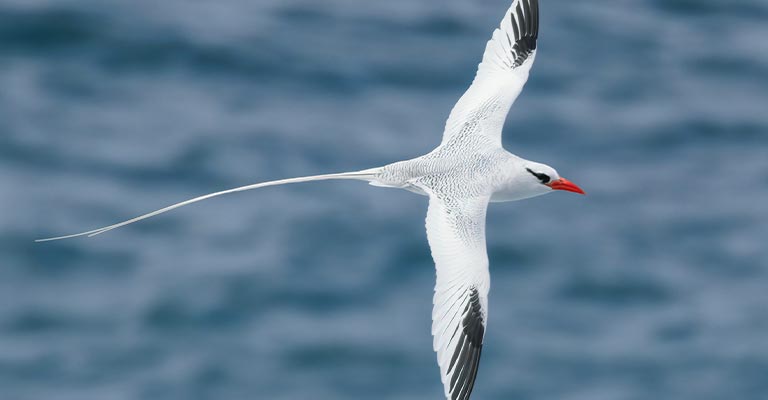
The Red-billed Tropicbird (Phaethon aethereus) is a captivating seabird renowned for its elegant appearance and graceful flight.
This species inhabits tropical and subtropical regions around the world, where it is known for its distinctive red bill and long, streaming tail feathers.
Understanding the life history of the Red-billed Tropicbird involves exploring various aspects of its ecology, behavior, and conservation status.
Food
Red-billed Tropicbirds primarily feed on fish and squid, which they catch by plunge-diving from great heights into the ocean waters below.
Their diet consists mainly of small pelagic species, such as flying fish and squid, which they capture with their sharp beaks while in flight.
Habitat
These seabirds inhabit remote coastal cliffs, rocky islands, and coral atolls, where they nest and breed in colonies.
They are highly adapted to a marine lifestyle, spending the majority of their time at sea, except during the breeding season when they return to land to reproduce.
Range Map

The range of the Red-billed Tropicbird spans tropical and subtropical waters around the world, including regions such as the Caribbean, the Gulf of Mexico, the central and eastern Pacific Ocean, and the Indian Ocean.
Their distribution is primarily determined by the availability of suitable nesting sites and foraging grounds.
Nesting
Red-billed Tropicbirds typically breed in colonies, constructing simple nests out of gathered debris in sheltered crevices or on cliff ledges.
The female lays a single egg, which is incubated by both parents for about 40-46 days. After hatching, the chick is cared for by both parents until it fledges at around 70-80 days old.
| Nesting Details | Facts |
| Clutch Size | Typically 1 egg |
| Number of Broods | Usually 1 per breeding season |
| Egg Length | Approximately 6.5 – 7.5 centimeters |
| Egg Width | Approximately 4.5 – 5.5 centimeters |
| Incubation Period | Around 40-46 days |
| Nestling Period | Approximately 70-80 days |
| Egg Description | Smooth, white with no markings |
| Nest Location | Cliff ledges or sheltered crevices |
Hunting Habit
These birds are adept hunters, using their keen eyesight to spot prey from high above the ocean surface.
Once prey is sighted, they execute spectacular plunge dives, often reaching depths of several meters to catch their prey with their sharp beaks.
Diseases and Treatment
Red-billed Tropicbirds may be susceptible to diseases common among seabird populations, including parasites and viral infections.
Treatment typically involves monitoring colony health, implementing measures to reduce stress and exposure to pathogens, and providing medical intervention when necessary.
Conservation
Conservation efforts for Red-billed Tropicbirds focus on protecting their breeding colonies, preserving their marine habitats, and mitigating threats such as habitat destruction, pollution, and disturbances to nesting sites.
Efforts also include monitoring populations, conducting research on their ecology and behavior, and raising awareness to promote their conservation.
By safeguarding these magnificent seabirds, we ensure their survival for future generations to admire and appreciate.
10 Fun Facts About Red-billed Tropicbird
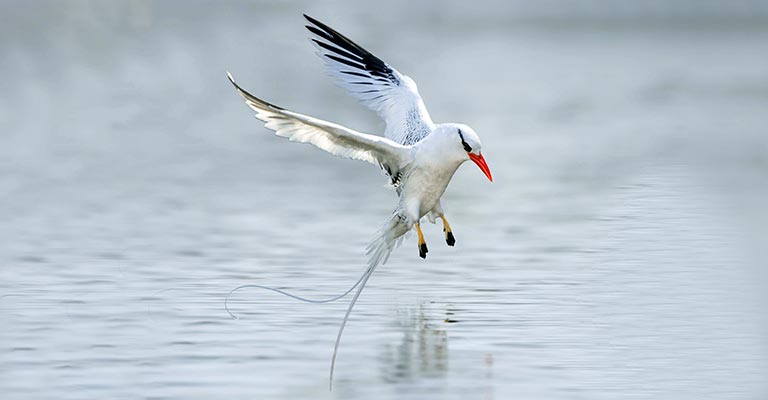
The Red-billed Tropicbird is a captivating seabird known for its striking appearance and graceful flight.
Found in tropical and subtropical regions around the world, this species never fails to fascinate with its unique characteristics. Here are 10 fun facts about the Red-billed Tropicbird:
- Distinctive Red Bill: As its name suggests, the Red-billed Tropicbird sports a vibrant red bill that stands out against its white plumage, making it easily recognizable.
- Long, Streaming Tail Feathers: One of the most striking features of this bird is its long, streaming tail feathers, which trail behind it in flight, adding to its elegant appearance.
- Effortless Gliders: Red-billed Tropicbirds are skilled aerialists, capable of gliding effortlessly over the ocean surface for extended periods without flapping their wings.
- Plunge Diving Hunters: When hunting for fish and squid, these birds execute spectacular plunge dives from great heights, using their sharp beaks to catch prey below the surface.
- Colonial Breeders: Red-billed Tropicbirds typically breed in colonies on remote coastal cliffs or rocky islands, where they construct simple nests out of gathered debris.
- Elaborate Courtship Displays: During the breeding season, pairs engage in elaborate courtship displays involving aerial acrobatics and mutual preening to strengthen their bond.
- High Nest Fidelity: These seabirds exhibit high nest fidelity, returning to the same breeding sites year after year to raise their young.
- Single Egg Clutches: Females typically lay only one egg per breeding season, which both parents take turns incubating for about 40-46 days.
- Long Nestling Period: It takes approximately 70-80 days for the chick to fledge and become independent, during which time it is cared for by both parents.
- Global Distribution: Red-billed Tropicbirds are found in tropical and subtropical waters around the world, including regions such as the Caribbean, the Pacific Ocean, and the Indian Ocean, delighting birdwatchers and nature enthusiasts everywhere with their beauty and grace.
Wrapping Up
The Red-billed Tropicbird stands as a testament to the beauty and resilience of seabirds worldwide.
With its striking appearance, graceful flight, and fascinating behaviors, this species captivates the hearts of birdwatchers and nature enthusiasts across the globe.
From its distinctive red bill to its long, streaming tail feathers, every aspect of the Red-billed Tropicbird embodies elegance and charm.
As we marvel at its aerial prowess and colonial nesting habits, we are reminded of the importance of preserving our marine ecosystems and protecting the habitats of these magnificent birds.
Through conservation efforts and continued admiration, we can ensure that future generations will also have the opportunity to admire and appreciate the Red-billed Tropicbird in all its splendor.